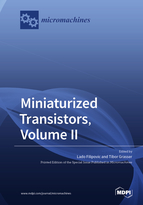Miniaturized Transistors, Volume II
A special issue of Micromachines (ISSN 2072-666X). This special issue belongs to the section "A:Physics".
Deadline for manuscript submissions: closed (31 March 2020) | Viewed by 99172
Special Issue Editors
Interests: integrated sensors; 2D material sensors; semiconductor metal oxide gas sensors; 3D integration; process TCAD
Special Issues, Collections and Topics in MDPI journals
Interests: transistor reliability; bias temperature instability; hot carrier degradation; degradation phenomena in emerging devices; modeling and simulation of semiconductor devices
Special Issues, Collections and Topics in MDPI journals
Special Issue Information
Dear Colleagues,
What is the future of CMOS? Sustaining increased transistor densities along the path of Moore's Law has become increasingly challenging with limited power budgets, interconnect bandwidths, and fabrication capabilities. In the last decade alone, transistors have undergone significant design makeovers; from planar transistors of ten years ago, technological advancements have accelerated to today's FinFETs, which hardly resemble their bulky ancestors. FinFETs could potentially take us to the 5-nm node, but what comes after it? From gate-all-around devices, stacked nanowires and nanosheets to single electron transistors, two-dimensional semiconductors and III-V devices, a torrent of research is being carried out in order to design the next transistor generations, engineer optimal materials, improve the fabrication technology, and properly model future devices. Furthermore, designing appropriate Ohmic contacts and metalization for these novel devices is no small feat and will require an in-depth look at new conducting materials, dielectrics, and innovative designs. We invite insight from investigators and scientists in the field to showcase their work in this Special Issue with research papers, short communications, and review articles which focus on trends in micro- and nanotechnology from fundamental research to applications.
Dr. Lado Filipovic
Prof. Dr. Tibor Grasser
Guest Editors
Manuscript Submission Information
Manuscripts should be submitted online at www.mdpi.com by registering and logging in to this website. Once you are registered, click here to go to the submission form. Manuscripts can be submitted until the deadline. All submissions that pass pre-check are peer-reviewed. Accepted papers will be published continuously in the journal (as soon as accepted) and will be listed together on the special issue website. Research articles, review articles as well as short communications are invited. For planned papers, a title and short abstract (about 100 words) can be sent to the Editorial Office for announcement on this website.
Submitted manuscripts should not have been published previously, nor be under consideration for publication elsewhere (except conference proceedings papers). All manuscripts are thoroughly refereed through a single-blind peer-review process. A guide for authors and other relevant information for submission of manuscripts is available on the Instructions for Authors page. Micromachines is an international peer-reviewed open access monthly journal published by MDPI.
Please visit the Instructions for Authors page before submitting a manuscript. The Article Processing Charge (APC) for publication in this open access journal is 2600 CHF (Swiss Francs). Submitted papers should be well formatted and use good English. Authors may use MDPI's English editing service prior to publication or during author revisions.
Keywords
- CMOS transistor scaling
- Advanced More Moore devices and circuits
- Nano-scale devices
- Nanoelectronics
- Nanostructures
- Quantum information processing
- Quantum physics
- Quantum transport Emerging devices and memories
- Fabrication of modern devices and interconnects
- Metalization
- Back end of line reliability
- Process reliability and variability
- Modeling and simulation of semiconductor processes and devices
- Compact modeling
- Circuit simulation








